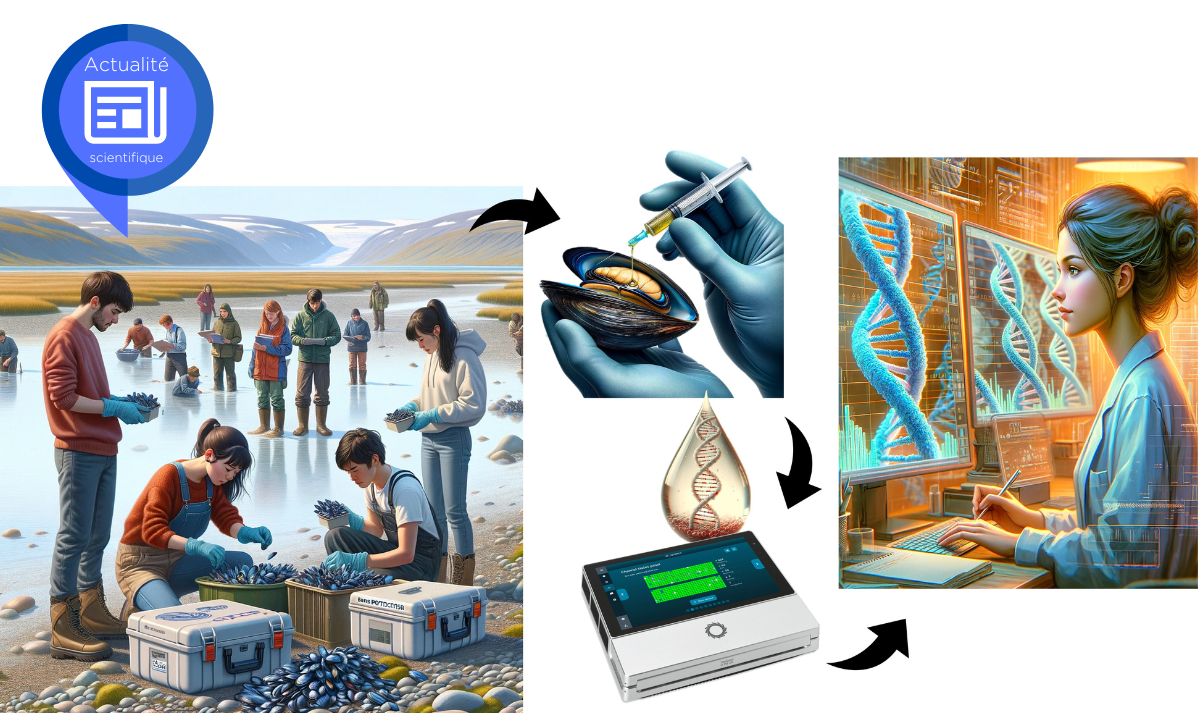Published on March 26 2024 In Scientific news
From human medicine to Nunavik mussels

An article by Valérie Levée, science journalist
Mussels have a lot to say: about their own state of health as well as that of their environment, about the pathogens they harbor, those that would be harmful to consumers, but also about the microorganisms present in the ecosystem around them that may be pathogenic to other species. To make mussels talk, Yves St-Pierre applies the methods used in human medicine.
Yves St-Pierre is a cancer researcher at the INRS-Armand-Frappier Santé Biotechnologie Research Centre. He began studying mussels in 2113, when his colleague Michel Fournier, also a professor at INRS, suggested that he transfer the expertise that he had developed on human white blood cells to the mussels of the Kerguelen Islands in Antarctica. This was the beginning of a new field of research in Yves St-Pierre's laboratory.
As missions to the Kerguelen Islands and technological developments progressed, Yves St-Pierre developed a method of analysis and sampling adapted to mussels: liquid biopsy.
"The first time we went to Kerguelen, we collected, sacrificed and dissected thousands of mussels. Now, with a syringe, we take a few milliliters of hemolymph and put the mussel back where we found it," explains Yves St-Pierre.
After centrifuging the hemolymph, the white blood cells and plasma are separated and placed on FTA cards, which are designed to keep DNA and RNA intact until they are returned to the laboratory. It's the plasma content that interests Yves St-Pierre.
In fact, human plasma contains bits of DNA and RNA, known as circulating DNA, which can provide a great deal of information.
"The concept of liquid biopsy is a very promising tool in oncology. Instead of taking a tissue biopsy to find out whether a patient has cancer, we can take a blood sample, isolate the circulating DNA, sequence it and, based on the sequencing information, tell whether the patient has a tumor, where the tumor is located and what mutations the tumor carries. This is important information for adjusting treatment", explains Yves St-Pierre.
The idea is to apply these medical advances to the mussel, not just to diagnose the health of the mussel, but that of the ecosystem as well. The mussel has one advantage over humans: it doesn't operate in a closed system. It filters seawater, so its plasma contains its own circulating DNA, the DNA of the microorganisms that colonize it and environmental DNA. In fact, "between 25 and 40% of the DNA found in the hemolymph does not belong to the mussel", points out Yves St-Pierre.
By analyzing this DNA, we can identify whether the microorganisms that the mussel harbors are pathogenic to itself or to humans. In Nunavik, where mussels are part of the traditional Inuit diet, the challenge is twofold: to prevent human illness and to maintain the mussel as a food resource. If a mussel bed is contaminated, one preventive measure would be to temporarily close it, thus preventing people from becoming poisoned and the pathogen from spreading to other mussel beds.
Environmental DNA contains the DNA of organisms present in the ecosystem that could possibly be pathogenic to other species. If the biopsy reveals DNA from a bacterium that is pathogenic to trout, this is an indicator that trout in the vicinity are infected. This can be verified by sampling the trout and, if necessary, putting intervention measures in place. "The liquid biopsy tells us if there's a problem, and once we've administered the solution, with further biopsies, we can follow up on the effectiveness of the solution," continues Yves St-Pierre.
Finally, as in humans, circulating DNA in mussel hemolymph is likely to provide information about mussel health, its response to pathogens and, more generally, its response to various environmental stresses. The research team is paying particular attention to DNA methylation in mussels. DNA methylation is a process that is highly sensitive to environmental stress, making it possible to detect non-apparent environmental stress.
This is the essence of the UVILUQ project, an INQ-SN project in Nunavik led by Yves St-Pierre in collaboration with Philippe Archambault, a professor in the Department of Biology, and Jacques Corbeil, a professor in the Department of Molecular Medicine, both at Université Laval.
"We want to create a platform for participatory research where people from the communities go to the mussel beds and take the biopsies. This would serve as a method for the continuous monitoring of pathogens that are harmful for human consumption or that could lead to the disappearance of resources," explains Yves St-Pierre.
The project, which began in July 2020, was hampered by the pandemic, which limited access to Nunavik. "We turned our attention to the Saguenay-St. Lawrence Marine Park and a great collaboration with Parks Canada biologists. We developed the sampling platform and conducted several proofs of concept," says Yves St-Pierre. Nevertheless, Philippe Archambault's team was able to conduct sampling in several Inuit communities. We have identified microorganisms that are potentially pathogenic to both humans and mussels," says Yves St-Pierre. Red lights are going on, but we need to do more research to see if they are really pathogens. The biopsies will undoubtedly tell us more about the health of the ecosystems.
To learn more:
Ferchiou, S., Caza, F., de Boissel, PG., Villemur, R., St-Pierre, Y. (2022) Applying the concept of liquid biopsy to monitor the microbial biodiversity of marine coastal ecosystems, ISME Communications 27;2(1):61.
https://www.nature.com/articles/s43705-022-00145-0
Ferchiou, S., Caza, F., Villemur, R., Betoulle, S., St-Pierre, Y. (2022) Species-and site-specific circulating bacterial DNA in Subantarctic sentinel mussels Aulacomya atra and Mytilus platensis, Scientific Reports 10;12(1):9547.
https://doi.org/10.1038/s41598-022-13774-1
Caza, F., Joly de Boissel PG., Villemur, R., Betoulle, S., St-Pierre, Y. (2019) Liquid biopsies for omics-based analysis in sentinel mussels, PLoS One 3;14(10):e0223525
https://doi.org/10.1371/journal.pone.0223525
____
Cover image: Illustration by Sophia Ferchiou, PhD candidate in biology, INRS.
____
 Science News
Science News
Spotlight on Northern Research | An initiative of Institut nordique du Québec
To celebrate Quebec's excellence in northern research and to highlight the various challenges and issues related to these territories, Institut nordique du Québec offers you a series of articles dedicated to the research conducted in its community.
Over the months, you will discover a multidisciplinary research community whose strength lies in the complementary expertise of its members. You will meet individuals who share a strong attachment to the North and who are dedicated to producing, in collaboration with the inhabitants of the region, the knowledge necessary for its sustainable and harmonious development.
You are invited to relay this and subsequent articles to your network, thus enabling the greatest number of people to discover the different facets of northern research and the many faces that animate it. Together for the North!
Back to news

